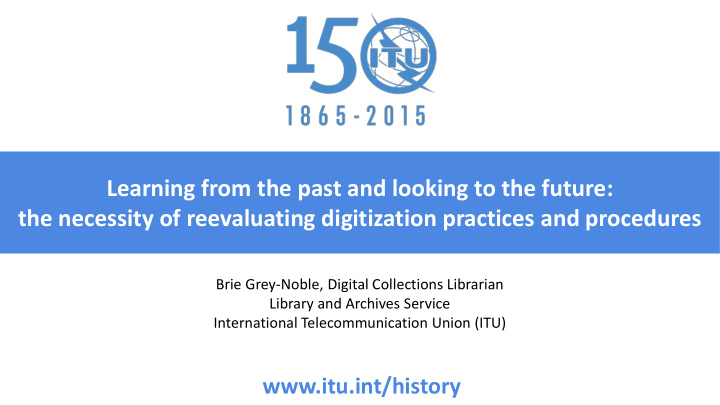



Learning from the past and looking to the future: the necessity of reevaluating digitization practices and procedures Brie Grey-Noble, Digital Collections Librarian Library and Archives Service International Telecommunication Union (ITU) www.itu.int/history
What is ITU? The International Telecommunication Union is the oldest existing international organization. Since 1865, ITU has been at the centre of advances in communications – from telegraphy through to the modern world of satellites, mobile phones and the Internet. www.itu.int/history 2
Mission of the ITU Library & Archives Service An important part of our mission is to acquire, preserve, and provide the best possible access to all ITU publications and official printed documents that result from its activities. www.itu.int/history 3
Why digitize? “In a world where it is increasingly felt that if it’s not online it doesn’t exist, we need to make sure that our users are exposed to the wealth of information in special collections” - Erway & Schaffner (2007) The rapid growth of the Internet has changed the way that people seek information. www.itu.int/history 4
Why digitize? Digitization has provided the opportunity to expand our mission by increasing access to many of ITU’s key publications and documents by making digitized versions available online. It has also enabled us to take an active role in telling ITU’s story by researching and selecting publications and documents to share on our web site, the History of ITU Portal. www.itu.int/history 5
Phase One: 2007-2009 • Limited resources • Scanning was sporadic • Very little assessment of print originals • Minimal quality control of digital files • At this stage, no specific procedures in place only a basic set of guidelines www.itu.int/history 6
From digitization project to Digitization Programme Project vs. Programme Defined beginning and end On-going part of daily operations Small scope Large scope Integrated into organization’s Objective is only to complete project mission and goals Dedicated resources to enable current Limited resources (project-specific) and future projects Our scanning project was expanded into a full-scale, on-going digitization programme with two main goals: • to produce high-quality, authoritative digitized versions of key ITU publications and documents; and • to tell the story of the International Telecommunication Union. www.itu.int/history 7
Phase Two: 2009-2013 • Increased resources • Critical approach to digitization process • Developed a workflow and standard procedures • Launched a web site to facilitate access to our digital files www.itu.int/history 8
Telling ITU’s story During phase two, we also came up with the idea to use our publications and documents to tell ITU’s story. As a result, providing an informed and authoritative history of the Union became a fundamental part of our digitization programme. www.itu.int/history 9
Phase Three: 2013-today • Began new project - digitization of ITU’s Journal • In parallel, continued digitization of conferences collection • Modified workflow and procedures • Prepared for our first outsourcing experience • Faced new challenges and limitations www.itu.int/history 10
Why digitize the Telecommunication Journal? As one of ITU’s oldest publications, it is a resource with enormous historical value and high research potential. Providing online access to the Journal will undoubtedly supply the research community with greater insight into the Union’s rich history. www.itu.int/history 11
Challenges, decisions, and limitations • Continuous publication series spanning nearly 150 years • Pre-scanning assessment and preparation • Supplement series www.itu.int/history 12
Challenges, decisions, and limitations • Quality control • File format • Access and delivery • Integrating historic and current issues www.itu.int/history 13
What we have learned • Document decisions as they are made • Respond to decisions by modifying procedures • Be open and flexible! What has worked in the past won’t necessary work for future projects www.itu.int/history 14
Further information www.itu.int/history Contact library@itu.int 15
Recommend
More recommend